
Imaginarne mape zbiljskih mjesta.
Prikaz putova kroz London kao da je riječ o ljudskom probavnom traktu, od jednjaka do anusa.
From The Library Of Dr London
September 6, 2012
Click on this plate to enlarge and savour the full detail of Adam Dant‘s
map which describes a journey through London as if through the human
digestive tract from the mouth in Whitehall to the rectum in
Whitechapel. Adam has taken liberties with anatomy to place the brain in
Westminster, the liver in Fleet St, the heart at St Paul’s, the stomach
in the City and the genitals in the East End. Yet it all serves to
illustrate his notion that “London is akin to a voracious and hungry
organism with the Thames running through it as a peristaltic gut
continually in motion.”
This is just one of series of ingenious
maps of big cities that Adam has contrived to capture their essential
qualities, portrayed in huge ink drawings of double-page plates from
volumes in the mythical Library of Dr London – all executed while
touring around European capitals this summer and exhibited in a show
which opens tonight at Hales Gallery.
Map of the City of London as a stained glass of Gog & Magog – Logos of corporate finance stand in place of crests of the livery companies.
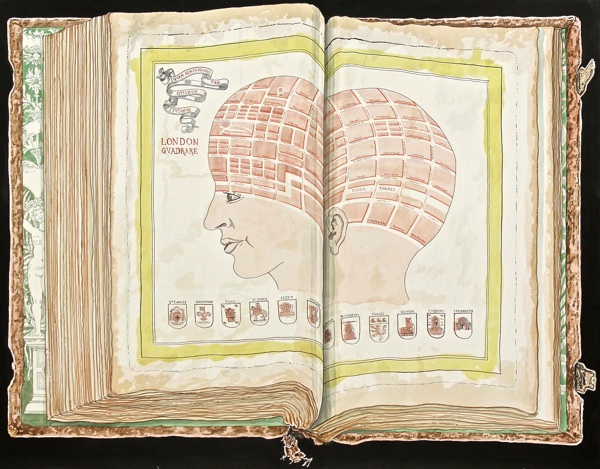
The capital as a phrenological diagram, indicative of the desire for social order expressed by London’s squares.

Paris – The Bones of Liberty. The figure of “Liberty Leading the People” by Delacroix is manipulated to correspond to Baron Hausmann’s street plan.
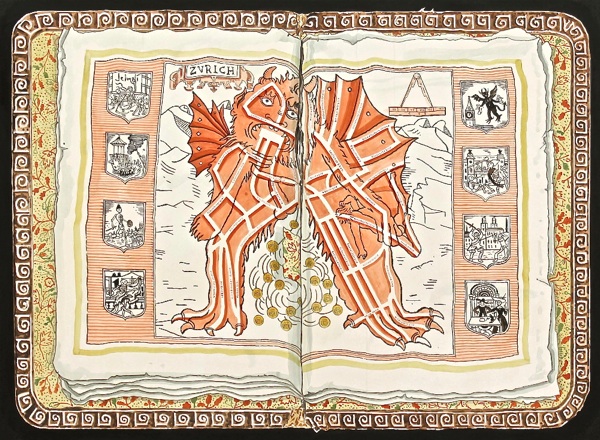
Zurich as Hellmouth - The mouth is located at the Bahnhof and the journey to its arse, where it shits coins into Lake Zurich, runs through the Bahnhofstrasse which is home to the biggest banks with vaults containing more gold than anywhere else on earth.
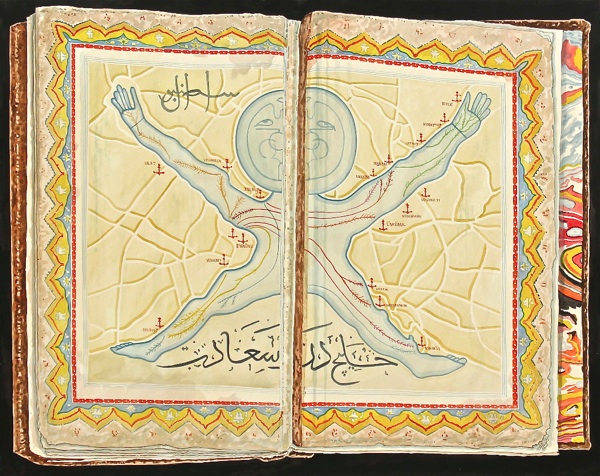
The Nerves of Istanbul - The inspiration was a medieval Persian medical diagram with the head turned upside down and, on this map, it corresponds to the more European areas – while the coloured nerves correspond to the ferries, which cross the Bosphorus carrying commuters who live on the Asian shore.
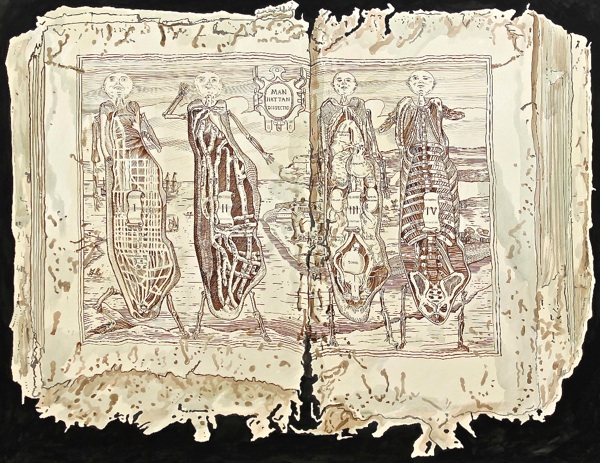
New York. Manhattan stripped bare in the four different ways – the vessels, the entrails, the organs and the ribs.

Toyko – Shunga Metro Map. Tokyo is personified in a subterranean fashion through wrestling figures intertwined to form the lines of the subway.

Adam Dant spent the summer touring Europe with his peripatetic atelier to create the exhibition.
Drawings copyright © Adam Dant
http://spitalfieldslife.com/2012/09/06/from-the-library-of-dr-london/
.
Artist of the week 207: Adam Dant
Dant's
fantastic maps, charts and satirical projects – such as
'underneathism', the painstaking depiction of things from below – show a
peculiarly British wit
Adam Dant's hyper-detailed drawings are like objects magicked
out of a fictional realm. With their ornate borders and trompe l'oeil
crinkled edges, his fantastic maps, books and charts navigate worlds whose strange territory seems to depend on figures of speech or even hallucinations. His Bureau for the Investigation of the Subliminal Image
included studies of self-portraits supposedly hidden in paintings in
the Louvre. Dant meticulously documented these concealed images,
apparently rendered subconsciously by artists, as if they were part of
orthodox art history. Elsewhere, he has turned categorisation itself on
its head with "underneathism", painstakingly depicting from below
everything from supermarkets to beach life.
His peculiarly British wit extends to social satire: the Princesses Beatrice and Eugenie are among the tabloid favourites whose public personas Dant has imaginatively unpicked, earning him comparisons with Hogarth. Furthermore, his works – especially Donald Parsnips Daily Journal, one of his first projects – frequently resemble the output of an 18th-century press. They're more like pamphlets to be pored over in coffee shops, not galleries.
Trained as a graphic designer, Dant is an adept practitioner of traditional printing methods, a skill he acquired almost by chance when he took a student exchange place at an Indian university in the 1980s, and was surprised to find himself presented with wood and chisel, unaware that graphic design in India then meant print-making.
In the late 1990s, he handed out 100 copies daily of the Parsnips journal to an unsuspecting readership in London, Paris, Cairo and beyond. His latest works go back further, to Renaissance analogies between the body and cities and architecture. Meanwhile, From the Library of Dr London consists of huge drawings depicting maps in antique books. They chart the world's major metropolises not as grids of streets, but in terms of what they make us think of.
In one work conflating art history with recent news stories, nude figures recalling traditional Japanese erotic prints stretch their limbs around a map of Tokyo's subway – a place notorious for sexual harassment. In another, the main thoroughfares of Paris, a city whose guidebook splendour belies revolution-era France's socialist ideals, are mapped on to the bones of Liberty.
Why we like him: For British Drinking, depicting revelry on Shoreditch's Redchurch Street. Dant has witnessed this little road around the corner from his studio grow into a hub for East End nightlife, and here he packs it with characters who each embody slang for getting drunk, including badgered, mullahed and Dot Cotton (rhyming slang for rotten). A dishevelled Boris Johnson is "drunk as a lord".
Weird science: Dant is a member of the London Institute of 'Pataphysics, a continuation of Alfred Jarry's "science of imaginary solutions". Members of its European equivalents have included Umberto Eco and one of Dant's big influences, the literary group Oulipo.
His peculiarly British wit extends to social satire: the Princesses Beatrice and Eugenie are among the tabloid favourites whose public personas Dant has imaginatively unpicked, earning him comparisons with Hogarth. Furthermore, his works – especially Donald Parsnips Daily Journal, one of his first projects – frequently resemble the output of an 18th-century press. They're more like pamphlets to be pored over in coffee shops, not galleries.
Trained as a graphic designer, Dant is an adept practitioner of traditional printing methods, a skill he acquired almost by chance when he took a student exchange place at an Indian university in the 1980s, and was surprised to find himself presented with wood and chisel, unaware that graphic design in India then meant print-making.
In the late 1990s, he handed out 100 copies daily of the Parsnips journal to an unsuspecting readership in London, Paris, Cairo and beyond. His latest works go back further, to Renaissance analogies between the body and cities and architecture. Meanwhile, From the Library of Dr London consists of huge drawings depicting maps in antique books. They chart the world's major metropolises not as grids of streets, but in terms of what they make us think of.
In one work conflating art history with recent news stories, nude figures recalling traditional Japanese erotic prints stretch their limbs around a map of Tokyo's subway – a place notorious for sexual harassment. In another, the main thoroughfares of Paris, a city whose guidebook splendour belies revolution-era France's socialist ideals, are mapped on to the bones of Liberty.
Why we like him: For British Drinking, depicting revelry on Shoreditch's Redchurch Street. Dant has witnessed this little road around the corner from his studio grow into a hub for East End nightlife, and here he packs it with characters who each embody slang for getting drunk, including badgered, mullahed and Dot Cotton (rhyming slang for rotten). A dishevelled Boris Johnson is "drunk as a lord".
Weird science: Dant is a member of the London Institute of 'Pataphysics, a continuation of Alfred Jarry's "science of imaginary solutions". Members of its European equivalents have included Umberto Eco and one of Dant's big influences, the literary group Oulipo.
Adam Dant
Hales Gallery, London, UK

Adam Dant From the Library of Dr. London, 2012
The casual, anthropomorphic metaphors of city residents are often
confined to the internal organs of an imagined body: one either travels
to the heart of a metropolis for its centre, or down, via an intestinal
subway system, into its bowels. In London: The Biography (2000)
maverick biographer, novelist and critic Peter Ackroyd encouraged the
reader to envisage the city as an entire human form. Whether considering
this figure as a healthy giver of life or a ‘swollen and dropsical
giant’, Ackroyd plots a route through the vivid urban landscape of
London’s built environment. For his recent solo exhibition ‘From the
Library of Dr London’, Adam Dant used the city-as-body metaphor to
create maps of London, but also of Zurich, Istanbul, Monaco, Tokyo,
Manhattan and Paris. Shifting perspective from the molly houses and
grimy cobblestone close-ups of Ackroyd, the British artist’s views are
from above, recasting parks, districts and roads as body parts, organs
and bones. The result is a kind of cartographical satire, one that
ranges over the same subversive landscape as James Gillray’s political
caricature maps and Steve Bell’s long-running Guardian cartoon strip If… Like General Idea’s ‘1970 Miss General Idea Pageant’, or Charles Avery’s ongoing work on ‘Onomatopoeia Island’ (begun in 2005), Dant has created a fictional narrative to generate the production of his body-map works. Each of the nine, framed drawings depict giant, antiquated books opened at double-page spreads, across which the city-as-body is illustrated. The tomes have been taken from the library of Dr. London, an enigmatic figure and antiquarian futurist, created by Dant, who uses drafting techniques and cartographic tropes from the past to capture an absurdist vision of our urbanized present.
The works were made during the London 2012 Olympics and, in response to the heady optimism of those events, there is a raw undercurrent to their absurd surface. Perhaps the single most prominent political gesture of Dant’s endeavour is that cities are not portrayed as heroic figures: the city-men are pathetic, sickly looking creatures, flayed and exposed like subjects arranged for an écorché. In From the Library of Dr London (all works 2012), landmarks of central London and its East End are distributed amongst the exposed vital organs of a lank-necked, wide-eyed cadaver. Manhattan Dissected features four similarly flayed corpses, each with a different level of anatomy exposed. The symbolism of a dead city is clear. Both Manhattan and London have been transformed by new developments, and while each city trumpets its uniqueness around the world, urban reality, for citizens traversing soulless developments of glass and steel, can seem as lifeless as a limp carcass.
The psychological effect of the city-as-body image is that it encourages the viewer to consider the city of London as a single entity. Instead of the isolated borough snapshots currently in vogue (as in Zadie Smith’s N.W. or John Lanchester’s Capital, both of which were published earlier this year), the corporeal city stands together. Unfortunately, neat sectoral divisions of London hold sway in the collective conscious. Thus psychologically divided and unchallenged by the populous, vast sectors of the city are regenerated into privatized nowhere lands, and the blank architectural model of Canary Wharf is rolled out across the capital.
Elsewhere, Dant’s anthropomorphic project leads to a more playful, if slightly essentialist, engagement with his source material. Shunga Metro reinterprets Tokyo’s subway map as a series of sexually interlinked, top-knotted men and geishas, and Hellmouth Zurich pictures the city as a giant, bat-winged demon. But it is the flayed image of London in From the Library of Dr. London that lingers in the mind as a bleak simile for the capital. Outside Hales Gallery’s Shoreditch space, rows of stacked shipping containers have been transformed into temporary retail outlets – a reminder that money has historically been the city’s driving force, and transforming the metropolis into a giant wall-less shopping precinct, with no inch of land spared, is a sure-fire way to guarantee its circulation today. As an antidote to the consume-at-all-costs ethos saturating most corners of the capital, From the Library of Dr. London reminds us London is still in need of a post-2011 riots, post-2012 Olympics post-mortem. - Morgan Quaintance
The Redchurch St Rake’s Progress
Map of Hoxton Square
Hackney Treasure Map
Map of the History of Shoreditch
Map of Shoreditch in the Year 3000
Map of Shoreditch as New York
Map of Shoreditch as the Globe
Map of Shoreditch in Dreams
Map of the History of Clerkenwell
Map of the Journey to the Heart of the East End
Meeting of the Old & New East End in Redchurch St
The Redchurch St Rake’s Progress
June 17, 2011
Like it or not, Redchurch St has become the
street in London that is the focus of all that is fashionable and
happening, just as Carnaby St and the Kings Rd were in the sixties. When
artist Adam Dant
first came to Redchurch St in the nineteen nineties he remembers it
as mostly printers, button makers and other light-industry, but now it
is the white-hot hangout for those who are young and have money to throw
around in the bars and boutiques. Inspired by this unlikely and sudden
transformation from utilitarian to hedonistic, Adam Dant chose
the crossroads where Redchurch St meets Club Row as the terrain for his
panorama of “British Drinking” in the manner of Pieter Breughel’s social
landscapes – only rather than Flemish proverbs, Adam Dant has
illustrated English figures of speech for drunkenness to create an
sprawling epic of bacchanalia. (You can click on this and the other plates here to enlarge and study them in detail.)
Something extraordinary happens when so much cultural attention is paid to a single street, it becomes a theatre where people need to perform, carrying an invisible sign above their heads that says “Look at me, I’m on Redchurch St.” A phenomenon that you can witness any day of the week, simply by walking along Redchurch St and observing all the people trying very hard to be unselfconscious. The recent music video for R.E.M. shot by Sam Taylor-Wood and featuring her fiancée Aaron Johnson dancing down Redchurch St, manifests the apogee of this bizarre circumstance – and which also, by an extraordinary fluke of chance, features Adam Dant – who is a resident of Redchurch St – in a fleeting appearance walking his dog Edwin in the background.
As the definitive chronicler of the social change that has come upon this corner of Shoreditch, Adam Dant created a “Redchurch St Rake’s Progress” in the manner of William Hogarth – in which a Rake inherits and loses a fortune upon a single block on Redchurch St. Setting each of the eight intricate tableaux outside buildings on the South side of the street, the series follows the fortunes of the Rake from flourishing his credit card on the corner of Club Row to ending up naked in the gutter at the corner of Chance St. If you have visited Redchurch St on one of the “First Thursdays” recently, when all the galleries have openings and give away free beers, and everyone wanders up and down, enjoying the party, you may recognise the scenes of revelry and rumpus illustrated here.
The young Rake takes possession of his wealth at the corner of Club Row and Redchurch St.
The Levee – the Rake surrounded by artists and hangers-on outside Lounge Lover.
The Rake enjoys an orgy on the pavement outside Watson Bros gunmakers.
The Young Rake is arrested for debt – confronted with his tab outside Museum 52.
The Marriage – outside “The Gallery in Redchurch St.”
The Gaming House – The Rake loses his fortune outside forty-eight Redchurch St.
In the Debtor’s Prison – The Rake and his possessions are thrown into the street outside the Outside World Gallery.
The Madhouse - Final depravity, the Rake is abandoned at the corner of Redchurch St & Chance St.
The original drawings of Adam Dant’s ”Redchurch St Rake’s Progress” will be on display for Spitalfields Life readers from today and over this weekend at Hales Gallery in the Tea Building in the Bethnal Green Rd – just ask to see them.
Something extraordinary happens when so much cultural attention is paid to a single street, it becomes a theatre where people need to perform, carrying an invisible sign above their heads that says “Look at me, I’m on Redchurch St.” A phenomenon that you can witness any day of the week, simply by walking along Redchurch St and observing all the people trying very hard to be unselfconscious. The recent music video for R.E.M. shot by Sam Taylor-Wood and featuring her fiancée Aaron Johnson dancing down Redchurch St, manifests the apogee of this bizarre circumstance – and which also, by an extraordinary fluke of chance, features Adam Dant – who is a resident of Redchurch St – in a fleeting appearance walking his dog Edwin in the background.
As the definitive chronicler of the social change that has come upon this corner of Shoreditch, Adam Dant created a “Redchurch St Rake’s Progress” in the manner of William Hogarth – in which a Rake inherits and loses a fortune upon a single block on Redchurch St. Setting each of the eight intricate tableaux outside buildings on the South side of the street, the series follows the fortunes of the Rake from flourishing his credit card on the corner of Club Row to ending up naked in the gutter at the corner of Chance St. If you have visited Redchurch St on one of the “First Thursdays” recently, when all the galleries have openings and give away free beers, and everyone wanders up and down, enjoying the party, you may recognise the scenes of revelry and rumpus illustrated here.
The Levee – the Rake surrounded by artists and hangers-on outside Lounge Lover.
The Rake enjoys an orgy on the pavement outside Watson Bros gunmakers.
The Young Rake is arrested for debt – confronted with his tab outside Museum 52.
The Marriage – outside “The Gallery in Redchurch St.”
The Gaming House – The Rake loses his fortune outside forty-eight Redchurch St.
In the Debtor’s Prison – The Rake and his possessions are thrown into the street outside the Outside World Gallery.
The Madhouse - Final depravity, the Rake is abandoned at the corner of Redchurch St & Chance St.
Pictures copyright © Adam Dant
Just as Hogarth featured his pug in the
Rake’s Progress, Adam Dant’s dog Edwin can be seen in the right hand
corner of the picture above. Can you spot Adam and his dog in the
background of the Sam Taylor-Wood music video for R.E.M. featuring Aaron
Johnson dancing down Redchurch St? Click here to watch it and here to watch a parody.The original drawings of Adam Dant’s ”Redchurch St Rake’s Progress” will be on display for Spitalfields Life readers from today and over this weekend at Hales Gallery in the Tea Building in the Bethnal Green Rd – just ask to see them.
The Meeting of the Old & the New East End in Redchurch St
June 4, 2012
(Click to enlarge and explore this drawing)
In recent years, Redchurch St has become
the conduit through which the culture of the New East End has been
channelled into the Old East End, as the street that was once part of
the infamous Old Nicol slum has been transformed into London’s most
fashionable destination. At one end is Shoreditch, lined with new media
enterprises and expensive bars, while at the other end is Brick Lane,
with its street markets, leather shops and beigel bakeries. And in the
middle is Adam Dant, the last artist left on Redchurch St, living and working in the midst of the hullabaloo.Celebrated as a cartographer extraordinaire, Adam took his satirical pen in hand to create this epic social panorama of The Meeting of the Old & the New East End in Redchurch St populated with hundreds of characters, both real and mythological, that compose the identity of this notorious thoroughfare. At the far end, drunken Foxtons estate agents characterised by their pointy shoes and spiky haircuts collapse in a drunken heap while leaving The White Horse strip pub. Ken Livingston is about the run them over by driving a bendy bus round the corner as Boris Johnston falls off the open platform of a passing Routemaster. All this drama, yet you are merely on the threshold of Redchurch St.
Meanwhile, amongst those representing the Old East End, you may recognise Richard Lee, the bicycle parts seller whose family have been trading on Sclater St since 1880, and the young Charlie Burns, the legendary waste paper merchant who died recently at ninety-six, portrayed here at seven-years-old, put in a halter by his father to pull the waste paper cart round the City. Elsewhere in this extravagant fantasy (eerily not too far from the reality) the iconography of Old and the New East End appear to have become mixed up as members of Shoreditch House have relocated from their rooftop swimming pool to a flooded hole in the road and a pop-up brothel opens for business nearby. Amongst the mayhem unleashed in this tiny street by the surreal culture clash between flashy new money and long-term poverty, spot Terence Conran, Keira Knightley, Bud Flanagan, Pearlies behaving badly, a pack of dogs from Hoxton and urban foxes on the prowl.
“We are presented with a plastic version of the authentic, here at the City fringe,” Adam confided to me in a discreet whisper as we walked together down the street in question, “In Redchurch St, behind this scruffy fascia of poverty, people on laptops are designing apps.”
For local cognoscenti, Adam’s drawing is a chance to test your people-spotting skills while, for the rest of us, it is a welcome opportunity to chuckle at human folly.

Drawing copyright © Adam Dant
Adam Dant’s Map of Hoxton Square 2011
July 29, 2011
Click to see what goes on in Hoxton Square
Spitalfields Life contributing photographer Martin Usborne is leaving Hoxton Square, and he commissioned this map from Adam Dant as
a momento. Once it was the life of the square that drew the
photographer to live here but now it is the excess of life that is
driving him away. The drama and the craziness have reached such a pitch
that Martin has no choice but to take his leave, if he is ever to have
another night’s uninterrupted sleep in his life.Recently, Martin and Adam have identified more than seventy different “Hoxton Types” that may be spotted in the Square and which are illustrated here on the map. I imagine Martin looking down from his window in wonder, in the way that Mark Lester does in the film of “Oliver” when he awakens at Mr Brownlow’s house after being rescued from Fagin’s gang. Only, instead of the “Cries of London,” Martin looks out onto the rampage you see above, as portrayed in such loving graphic detail by Adam.
Whether you celebrate this as an exuberant libertarian paradise or whether you condemn it as the nadir of unpleasantness is a matter of mere opinion, but there is no doubt that in recent years Hoxton Square has become a phenomenon – a crowded playground where those who so desire are may lose their inhibitions and their wallets with ease. “It must have some charm or why would people come all the way from Essex to go there?” asked Adam, with a twinkle in his eye and his tongue firmly in his cheek.
Hoxton Square is the East End’s Garden of Earthly Delights, peopled with Dog Walkers, Art Collectors, Art World Dilettantes, Art Dealers, Haircuts,Cycle Couriers, Trustafarians, Hen/Stag Nights, Estate Ped-Heads, Bengali Boys, Postcode Gangstas, Shrouded Girls, Eccentric Designers, Foreign Students, Smartphone Addicts, Vertical Drinkers, Light Industry Dregs, VVV Stupid Fashions, Scruffy Journos, Graffiti Tourists, Lost Dutch Travellodgers, Italian Anarchists, Polish Labourers, Polish Benchdwellers, Homeless/Drugs, Homeless/Dogowners, Homeless/Chirpy, Hoxton Elderly,Fast Food Barons, Hippy Circus Parents, Shh! Lesbians, Brooklyn Hipsters, Tribally Tattooed Folk, Out of Place Parents, Trashy Waitresses, A.D.D. Children, Ladettes, Japanese Stylists, Drunk Bankers, General Dickheads, Clowns, Sanctioned Graffitists, Fixi Bores, Rentokill Workers, Ukranian Pole Dancers, Strip Club Patrons, Media Nodes, Screwtop Rosé Girls, Interns, Coffee Bores, BBC Drama Shoot Participants, Tamagotchi Billionaires, Fashion Shoots, Nigerian Shoe Vendors, Incongruous Joggers, Plain Clothes Cops, Fried Food Schoolkids, Flash Restaurateurs,Pissers, Sterodial Bouncers, Flower Shoppers, Sticky Tape Artists, Performance Artists, Tai Chi Beginners, Architecture Students, Council Planning Officers, Bicycle Thieves, Drugs Vendors – and Joseph Markovitch,and Martin Usborne and his dog Moose.
In the top left of this detail of the map you can see Martin Usborne (walking his dog Moose) and Joseph Markovitch, a native of Hoxton.
Images copyright © Adam Dant
Adam Dant’s Map of Shoreditch
July 19, 2010

It is my delight to publish Adam Dant‘s map drawn to celebrate the centenary of the newly renovated Arnold Circus bandstand. 
1. Iron Age Man establishes a track along what is now “OLD STREET”.
2. Christian Roman Soldiers worship at the source of the river Walbrook, now St Leonards.
3. Sir John de Soerditch rides against the French Spears alongside The Black Prince.
4. Jane Shore, a goldsmith’s daughter & lover of Edward IV dies in “a ditch of loathsome scent.”
5. “Barlow” the archer is given the dubious title “Duke of Shoreditch” by Henry VIII.
6. Christopher Marlowe murders the son of a Hog Lane innkeeper, he escapes prosecution.
7. Plague burials take place at “Holywell Mound” by the Priory of St John the Baptist at Holywell.
8. Queen Elizabeth I on passing by medieval St Leonards is “Pleased by its Bells.”
9. The sweet water of “The Holywell” is spoilt by manure heaps of local nursery gardens,
10. James Burbage’s sons Cuthbert & Richard dismantle “The Theatre” in two to four days & transport it to the South bank of the Thames where it is rebuilt as “The Globe”.
11. William Shakespeare enjoys a “bumper” at an inn on the site of the present “White Horse.”

12. Local Huguenot weavers riot for three days protesting against & burning “multi-shuttle looms”.
13. Thomas Fairchild, a gardener, donated £25 to St Leonards for an annual Whitsunday sermon titled “Wonderful Works of God in creation” or “On the certainty of resurrection of the dead proved by certain changes of the animal and vegetable parts of creation.”
14. Militia are called from the Tower to quell four thousand Shoreditch locals rioting against cheap Irish labour being used to build the new George Dance tower of St Leonards.
15. Large lumps of masonry fall onto the congregation during a service at the collapsing old St Leonards.
16. The Huguenot speciality “fish & chips” appear at Britain’s first fish & chip shop on Club Row.
17. The many murders & muggings at Holywell Mount lead to it being levelled.
18. Local theatres such as The Curtain sink to become “no more than sparring rooms.”
19. Brick Lane takes its name from local brickfields, occasional location of furtive criminality.
20. Visitors to James Fryer’s land at Friar’s Mount wrongly assume a monastery stood there.

21. Joe Lee, the local horsewhisperer, coaxes improved productivity from working donkeys.
22. “Resurrection Men,” notorious body snatchers pinch recent interred corpses from St Leonards, some coffins in the crypt are found to contain bricks instead of bodies,
23. Four thousand people are dispossessed as Bishopsgate Goods Yard replaces streets around Swan Lane & Leg Alley.
24. Mary Kelly’s funeral procession leaves St Leonards amidst huge crowds. The poor victim of Jack the Ripper is given a second funeral at her own catholic cemetery.
25. Oliver Twist is said to have resided in Shoreditch. Many other unfortunate children arrive each morning at The White St Child Slave Market seeking work.
26. So many unruly pavement-side street vendors populate Shoreditch High St that a regular uniformed Street Keeper is employed.
27. Horse drawn trams add to the general commotion bustle and smell of the High Street.
28. Cats meat sellers, watercress hawkers & dog breeders all cram into the Old Nichol’s filthy tenements.
29. Sir Arthur Arnold, head of the LCC main drainage committee is commemorated at Arnold Circus.
30. For decades the chalk horse on Bishopsgate Goods Yard is redrawn by unknown local artist.
31. Enthusiastic Anarchists hoping to bring political awareness to the Old Nichol proletariat through their Boundary St printing operation find the task “like tickling an elephant with a straw.”
32. Artist, Lord Leighton calls the interior of Holy Trinity, Old Nichol St, “The most beautiful in England.”
33. Arthur Harding’s memories of his slum boyhood, “van dragging” etc are recalled in “East End Underworld.”
34. Arthur Morrison pens his slum tale “Child of the Jago” following Reverend Jay’s invitation to the Old Nichol.

35. The chapel dedicated to Shakespeare on Holywell Lane is destroyed by a WWII bomb.
36. Syd’s Coffee Stall, now Hillary Caterers, is saved from destruction during an air raid as two parked buses shelter it from a bomb blast. Thomas Austen’s medieval chancel window is less fortunate.
37. Novelist Arthur Machen identifies a “leyline” running through the mystic ancient earthwork Arnold Circus.
38. King Edward VIII officially inaugurates Boundary Estate from a platform on Navarre St.
39. The Red Arrows pass over the bandstand en-route once more to the Queen’s Birthday.
40. Protestors eventually force the closure of Club Row animal market, once home to dogs, parrots, pigeons and the occasional lion cub.
41. Navarre St is used as a playground by children who carve their names into the brickwork.
42. Artist, Ronald Searle visits Club Row animal market to illustrate Kaye Webb’s “Looking at London.”
43. The resident Bengali flute player of Arnold Circus is often heard across the Boundary Estate on warm Summer evenings.
44. The IRA bomb which explodes on Bishopsgate disturbs the rats in Shoreditch who emerge in large numbers from the drains,
45. The great train robbers plan their notorious crime upstairs in The Ship & Blue Ball, Boundary St.
46. Jeremiah Rotherham demolishes the Shoreditch Music Hall for another warehouse.
47. Joan Rose‘s father proudly displays his fruit & vegetables on Calvert Avenue whilst she is sent to buy more bags at Gardners Market Sundriesmen (still trading today).
48. Every type of vacuum cleaner bag is sold by “Zammo from Grange Hill’s dad” at Shoreditch Domestics on Calvert Avenue.
49. The failed Suicide Bus Bomber is seen by security camera leaving the No 26 at Shoreditch.
50. Mono-recording virtuoso, Liam Watson strides past Shoreditch’s “Elvisly Yours” souvenir shop en-route to legendary Toe-rag recording studios in French Place.
Adam Dant’s Map of Shoreditch as New York
November 13, 2010
“People do say they like the New Yorky feel, here in Shoreditch,”
admitted Adam Dant with a wily smile and a discernible twinkle in his
eye, when I asked him how he came to draw this map of Shoreditch as New
York. In this arresting vision, (A double click will enlarge the map to
fill your screen) Old St roundabout is transformed into Old St Circle,
Arnold Circus Park becomes Madison Square Gardens and Liverpool St
Station becomes Grand Central Station. In this metamorphosis, the
buildings and terminology are Americanised too, Brick Lane becomes Brick
Lane Avenue, Bethnal Green Rd becomes Bethnal Green Boulevard and
Quaker St becomes simply Quaker. Commissioned in 2003 by the Shoreditch
Map Company, the original painting now hangs above the table football
machine in Bar Kick in Shoreditch High St, where Adam and I went to have
a look at it yesterday. Unsurprisingly, we were told it is the subject
of a great deal of discussion in the bar.
When you come to think about it, the comparison becomes less far fetched than you might assume, because Broadway in New York is along the line of an ancient pathway followed by the Algonquin tribe, whereas in Shoreditch, Old St follows the route of a primeval trackway of the ancient Britons, and Canal St in New York follows the route of the former canal whereas Shoreditch takes its name from the “Suer” that was once ditched and is now piped off. Both places are renowned for their mix of artists and immigrant culture, and down in Brushfield St, on the site of the Spitalfields Market, Adam has drawn New York’s Ellis Island building in acknowledgement of the immigrants who have come to New York and Spitalfields, defining the nature of these locations today.
Looking around the neighbourhood, you quickly come upon further clues. We have Rivington St here just as they do, and Broadway Market and Columbia Rd too, chiming with New York. And the extension of the Great Eastern Railway up to Old St created a narrow triangular plot, occupied by a tall tapered building at the bottom of Great Eastern St which is reminiscent of the Flat Iron Building. Many people live in lofts in this vicinity today just as you might find in Soho or Tribeca and, of course, we have Shoreditch House whereas in New York they have Soho House, though I am reliably informed our rooftop pool deck is bigger than theirs.
In Adam’s vision, the Bishopsgate Goods Yard is transformed into a park, something many residents would like to see. Wheler St crosses the yard beneath a bridge just as 79th St crosses Central Park, while the elevated garden upon the former railway arches that Adam has drawn resembles the Highline Park in Chelsea – and a similar proposal has been made here, to transform the continuation of the Bishopsgate Arches over in Pedley St into a raised park. On Sundays, you will find the Chelsea fleamarket in the West Village, and here in Sclater St and Bethnal Green Rd. In Summer months, young people fill Hoxton Square, just as their transatlantic counterparts fill Washington Square.
The impetus behind Adam’s map was the Situationists, who would take a map of Paris to the Sahara Desert, exploring the strange poetry of transferring a map from one area and applying it to another. Inspired by the Situationist movement, Adam had previously done a project of Reading as Rome, in which he staged a casting call in Reading for “Reading Holiday,” a remake of the classic Audrey Hepburn, Gregory Peck movie, relocated to Reading – using a Lambretta and back projection of the streets of Reading. “I tried to take photos of Reading where it could pass for Rome,” Adam explained to me with a smirk, as we walked back from Bar Kick to his studio in Club Row, “It was bloody difficult.”
Then we were both stopped in our tracks by an image on a passing courier truck in Redchurch St, showing New York viewed through Tower Bridge grafted onto the Brooklyn Bridge. But was it Tower Bridge joining the Brooklyn Bridge across the East River with Manhattan in the background? Or was it London with the New York Financial District transferred to Shad Thames? Was it London as New York or New York as London? We stood and looked at each other in amazement…

The courier truck in Redchurch St, is this London or New York?
As we all know, for some people Shoreditch
is the world. They do not need to go beyond this especially vibrant
corner of the East End to find everything they require in life. If you
would like to experience the total Shoreditch-centric view of the world
for yourself, simply double click on the image above and this map will
expand at once to fill your entire field of vision – providing a elegant
visual parallel to the mysterious phenomenon that many discover when
then come to Shoreditch and find everywhere else quickly retreats to the
outer margins of their consciousness.
Adam Dant drew it ten years ago as a commission for the Shoreditch Map Company who produced a regular broadsheet listing all the bars and happening places that aspiring hipsters might seek out as a means to immerse themselves in the life of the neighbourhood. “There is a certain cliche you always hear, that London is a collection of villages,” he explained to me, “so I took that idea literally – as if Shoreditch was someone’s world.”
Adam found his inspiration in the fourteenth century Mappa Mundi that described the medieval world view with Jerusalem and the Holy Land at the centre, and he transposed its guiding principles to Shoreditch which is focused upon the dynamic nexus of Curtain Rd, Rivington St and Shoreditch High St. Just as the Mappa Mundi ended at the edge of the known world, Adam’s map is circumscribed by Spitalfields to the South and Hackney to the North, while Arnold Circus and Old St Tube Station are the landmarks which define the Eastern and Western extremities of Shoreditchland, beyond which only the most adventurous hipsters stray.
There has always been a vigorous broadsheet and pamphleteering tradition existing here at the margins of the City, and Adam chose to draw upon the colourful iconography of these publications in peopling his map of Shoreditchland, as a means to evoke the exuberant life that these streets have witnessed over the past five hundred years. He has created a map to be relished by cartographic connoisseurs, full of myriad signs and wonders, from the Eskimo in the frozen North of Hackney to Neptune in his chariot proceeding along Norton Folgate and further South in Bishopsgate, you see the winged figure of Mammon rising triumphant over the City. The pretence of scientific objectivity that more conventional maps peddle is rejected here, in favour of Adam’s preference for plotting an imaginative landscape where the mythical, the temporal and the plain nonsensical co-exist side by side.
I can only wonder what those people thought who picked up Adam’s map in a bar as a guide for a night out, only to discover Shoreditch was an archipelago inhabited by freaks. Yet since Shoreditch is renowned for its exuberant fashion pioneers and stylistas, it is possible they were not in the least surprised, because equally extravagant sights are commonplace every day in Shoreditch High St, the major thoughfare through the mythical kingdom of Shoreditchland.
Adam Dant has more maps that we plan to show you over coming weeks, next time Shoreditch as Manhattan. His current exhibition Bibliotheques & Brothels runs at the Adam Baumgold Gallery, East 66th St, New York City until November 27th.
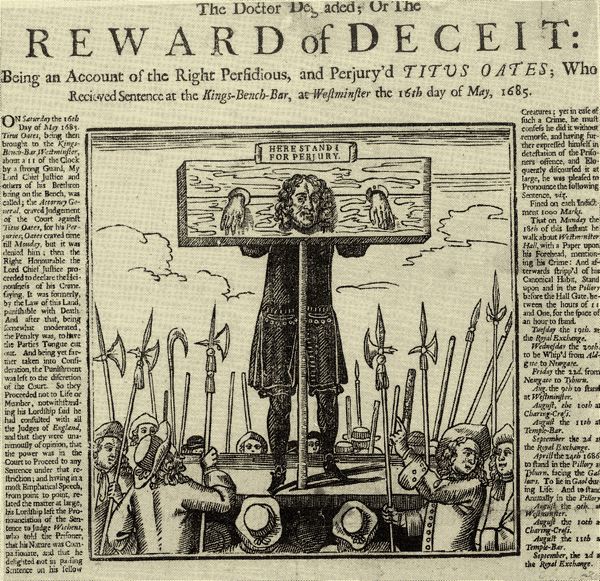
A satire upon the trial of Titus Oates from 1685, you will find Dr Degraded on Adam Dant’s map at the top just above Shoreditch Church.
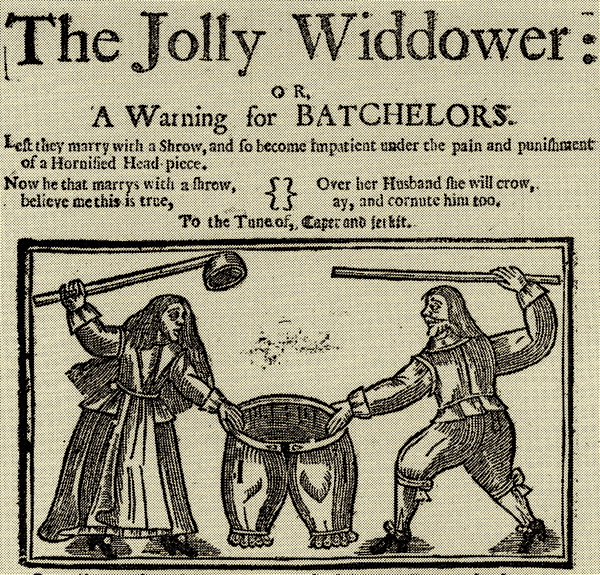
The fight over the breeches from 1690, you will find this couple outside Shoreditch Town Hall.
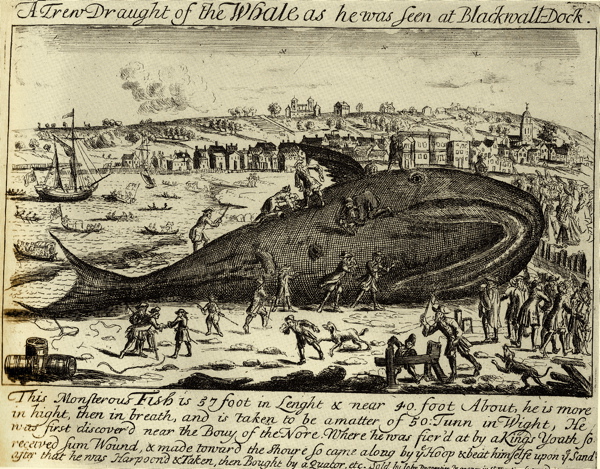
The whale beached at Blackwall Dock from 1690, you will find this creature in Great Eastern St.
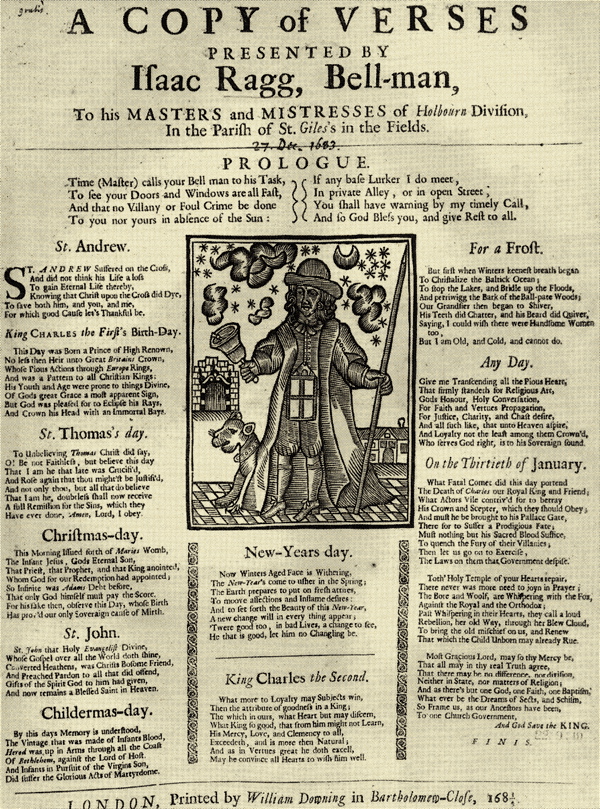
Isaac Ragg used this broadsheet to solicit New Year’s gifts in 1684, find him beside Brushfield St, Bell Lane, Spitalfields.
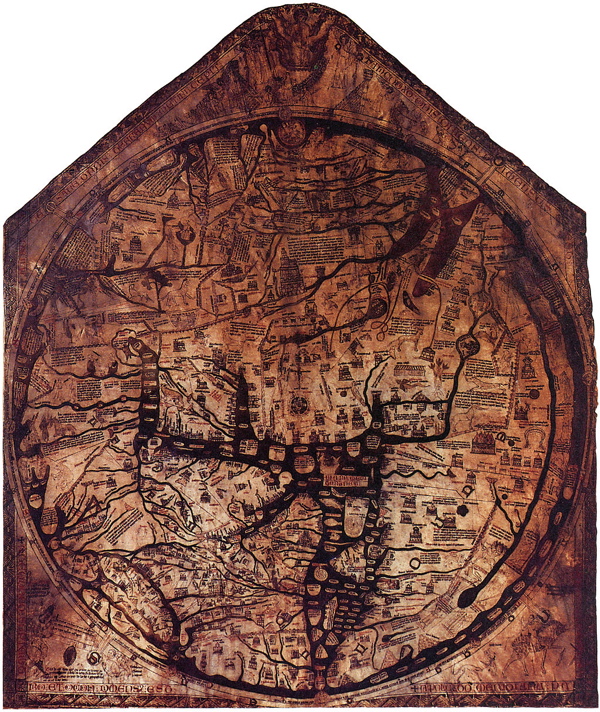
Hereford Mappa Mundi, c.1300
Daniel Langton served as Adam’s scout, making a reconnaissance by asking people on the street for the whereabouts of the heart of the East End and following their directions to the letter, however whimsical or strange. Some of the people “Scout Langton” encountered had never visited the territory before while others had lived here for generations, but all the directions they gave him led inexorably to the same location. Once the heart of the East End had been discovered, Adam designed his map around it, organising the postcodes of East London in a similar fashion to the map of central Paris which is structured around a spiral of the arrondissements in ascending numerical order. Thus his map charts the East End of popular conception and lore rather than the East End of conventional topography.
Those of us who are disappointed to learn that the consensus on the street is that a bin in Westfield Shopping Centre is perceived to be the heart of the East End, let us consider Odysseus. We may recall that while Ithaca was the purpose of his twenty-year voyage, Odysseus understood that Ithaca had given him a wonderful journey in itself. Let us contemplate Adam Dant’s map of the journey to the heart of the East End in the same spirit and take our consolation in the widely-held belief that “travelling is more important than arriving.”
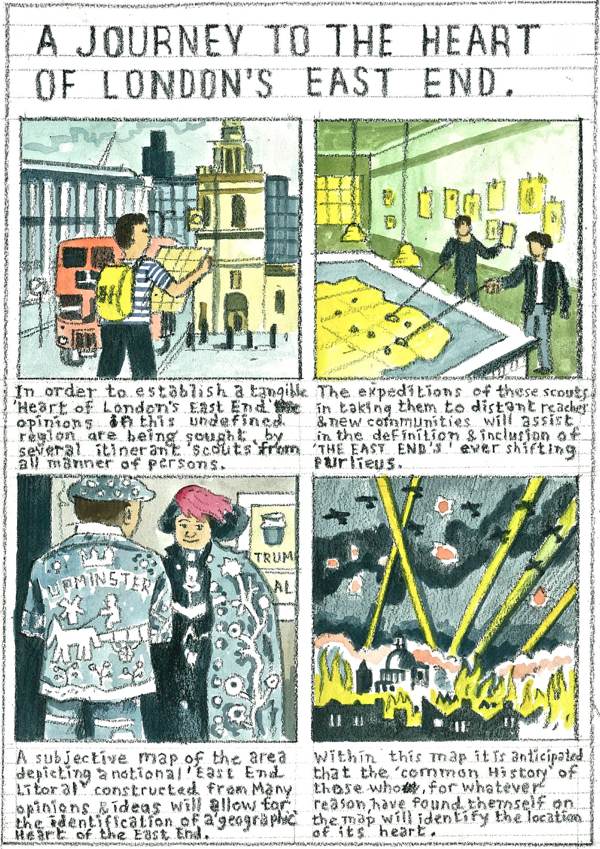
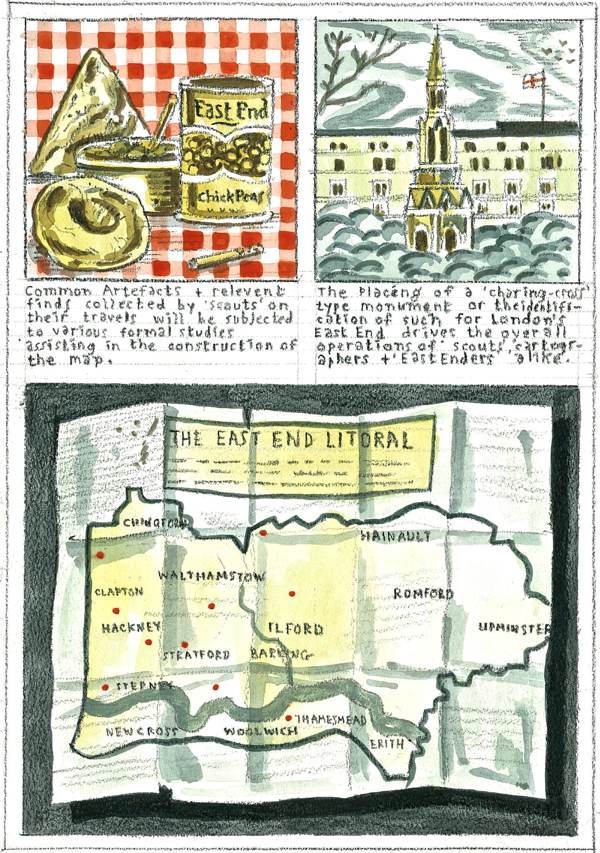

According to Adam Dant’s researches on behalf of the Museum of London, this waste bin in the Westfield Shopping Centre in Stratford marks the Heart of the East End.
When you come to think about it, the comparison becomes less far fetched than you might assume, because Broadway in New York is along the line of an ancient pathway followed by the Algonquin tribe, whereas in Shoreditch, Old St follows the route of a primeval trackway of the ancient Britons, and Canal St in New York follows the route of the former canal whereas Shoreditch takes its name from the “Suer” that was once ditched and is now piped off. Both places are renowned for their mix of artists and immigrant culture, and down in Brushfield St, on the site of the Spitalfields Market, Adam has drawn New York’s Ellis Island building in acknowledgement of the immigrants who have come to New York and Spitalfields, defining the nature of these locations today.
Looking around the neighbourhood, you quickly come upon further clues. We have Rivington St here just as they do, and Broadway Market and Columbia Rd too, chiming with New York. And the extension of the Great Eastern Railway up to Old St created a narrow triangular plot, occupied by a tall tapered building at the bottom of Great Eastern St which is reminiscent of the Flat Iron Building. Many people live in lofts in this vicinity today just as you might find in Soho or Tribeca and, of course, we have Shoreditch House whereas in New York they have Soho House, though I am reliably informed our rooftop pool deck is bigger than theirs.
In Adam’s vision, the Bishopsgate Goods Yard is transformed into a park, something many residents would like to see. Wheler St crosses the yard beneath a bridge just as 79th St crosses Central Park, while the elevated garden upon the former railway arches that Adam has drawn resembles the Highline Park in Chelsea – and a similar proposal has been made here, to transform the continuation of the Bishopsgate Arches over in Pedley St into a raised park. On Sundays, you will find the Chelsea fleamarket in the West Village, and here in Sclater St and Bethnal Green Rd. In Summer months, young people fill Hoxton Square, just as their transatlantic counterparts fill Washington Square.
The impetus behind Adam’s map was the Situationists, who would take a map of Paris to the Sahara Desert, exploring the strange poetry of transferring a map from one area and applying it to another. Inspired by the Situationist movement, Adam had previously done a project of Reading as Rome, in which he staged a casting call in Reading for “Reading Holiday,” a remake of the classic Audrey Hepburn, Gregory Peck movie, relocated to Reading – using a Lambretta and back projection of the streets of Reading. “I tried to take photos of Reading where it could pass for Rome,” Adam explained to me with a smirk, as we walked back from Bar Kick to his studio in Club Row, “It was bloody difficult.”
Then we were both stopped in our tracks by an image on a passing courier truck in Redchurch St, showing New York viewed through Tower Bridge grafted onto the Brooklyn Bridge. But was it Tower Bridge joining the Brooklyn Bridge across the East River with Manhattan in the background? Or was it London with the New York Financial District transferred to Shad Thames? Was it London as New York or New York as London? We stood and looked at each other in amazement…

The courier truck in Redchurch St, is this London or New York?
Adam Dant’s Map of Shoreditch as the Globe
November 6, 2010
Adam Dant drew it ten years ago as a commission for the Shoreditch Map Company who produced a regular broadsheet listing all the bars and happening places that aspiring hipsters might seek out as a means to immerse themselves in the life of the neighbourhood. “There is a certain cliche you always hear, that London is a collection of villages,” he explained to me, “so I took that idea literally – as if Shoreditch was someone’s world.”
Adam found his inspiration in the fourteenth century Mappa Mundi that described the medieval world view with Jerusalem and the Holy Land at the centre, and he transposed its guiding principles to Shoreditch which is focused upon the dynamic nexus of Curtain Rd, Rivington St and Shoreditch High St. Just as the Mappa Mundi ended at the edge of the known world, Adam’s map is circumscribed by Spitalfields to the South and Hackney to the North, while Arnold Circus and Old St Tube Station are the landmarks which define the Eastern and Western extremities of Shoreditchland, beyond which only the most adventurous hipsters stray.
There has always been a vigorous broadsheet and pamphleteering tradition existing here at the margins of the City, and Adam chose to draw upon the colourful iconography of these publications in peopling his map of Shoreditchland, as a means to evoke the exuberant life that these streets have witnessed over the past five hundred years. He has created a map to be relished by cartographic connoisseurs, full of myriad signs and wonders, from the Eskimo in the frozen North of Hackney to Neptune in his chariot proceeding along Norton Folgate and further South in Bishopsgate, you see the winged figure of Mammon rising triumphant over the City. The pretence of scientific objectivity that more conventional maps peddle is rejected here, in favour of Adam’s preference for plotting an imaginative landscape where the mythical, the temporal and the plain nonsensical co-exist side by side.
I can only wonder what those people thought who picked up Adam’s map in a bar as a guide for a night out, only to discover Shoreditch was an archipelago inhabited by freaks. Yet since Shoreditch is renowned for its exuberant fashion pioneers and stylistas, it is possible they were not in the least surprised, because equally extravagant sights are commonplace every day in Shoreditch High St, the major thoughfare through the mythical kingdom of Shoreditchland.
Adam Dant has more maps that we plan to show you over coming weeks, next time Shoreditch as Manhattan. His current exhibition Bibliotheques & Brothels runs at the Adam Baumgold Gallery, East 66th St, New York City until November 27th.

A satire upon the trial of Titus Oates from 1685, you will find Dr Degraded on Adam Dant’s map at the top just above Shoreditch Church.

The fight over the breeches from 1690, you will find this couple outside Shoreditch Town Hall.

The whale beached at Blackwall Dock from 1690, you will find this creature in Great Eastern St.

Isaac Ragg used this broadsheet to solicit New Year’s gifts in 1684, find him beside Brushfield St, Bell Lane, Spitalfields.

Hereford Mappa Mundi, c.1300
Adam Dant’s Map of Shoreditch in Dreams
November 27, 2010
For the finale of this series of maps of Shoreditch by Adam Dant,
it is my pleasure to publish the Map of Shoreditch in Dreams which Adam
drew in 1998 as his first map of the neighbourhood. As before, you
simply have to click on the image above to examine it in detail.
“I’d been thinking about how Shoreditch existed in people’s imaginations and subconscious and how I could render that visually,” explained Adam, “So I went to a lecture at the Jungian Society in Hampstead on the subject of ‘Collective Dreaming.’ It turned out to be a circle of people sitting in a room with a ‘dominatrix’ holding a clipboard – bobbed hair, German spectacles and pencil skirt – and she asked people to describe their dreams, with a view to explore common themes that might point to a collective unconscious. It was very embarrassing because people were revealing things about themselves that if they were aware of the language of psychoanalysis they would have kept mum.” Adding later in qualification, “I wasn’t using ‘mum’ in a Freudian sense.”
Taking his cue from the Jungian Society Lecture, Adam set out to collect the dreams of his neighbours and other residents through surveys and in conversation. Then he portrayed them all on the map you see above as a means to illustrate the heaving and teeming collective unconscious of Shoreditch. And I was astounded when Adam showed me the huge original drawing done directly in ink onto a piece of paper that is a metre square, without any single mistake or even an inkblot that might open itself to interpretation – almost obsessive compulsive in its neatness, you might say.
As we commenced our cartographic analysis, Adam explained that his orientation was looking to the West with a rat-infested Shoreditch High St crossing the map laterally, before he began to introduce me to a selection of the motifs. In the bottom left of the map, he pointed out the tiger prowling the streets continously and, further up to the right, the facades of the Boundary Estate propped up by wood, and then, over in Hoxton Square, the giant Teddy Bear at its centre. Images pregnant with meaning yet resisting simple interpretation. Most fascinating to me were the elements of premonition within the map – the giant pizza outside the Tea Building on the corner of the Bethnal Green Rd exactly on the site of the new pizza restaurant which opened more than a decade later and the bendy bus in the centre right of the map, drawn years before these strange vehicles became actuality.
You will note that this map was drawn and published under the name of Donald Parsnips, which was Adam Dant’s creative alter-ego at this time, and it is the image of Donald Parsnips in his tall hat that dominates the centre of the chart, produced when Adam was also publishing “Donald Parsnips’ Daily Journal” distributed in a daily edition of one hundred copies free to the people of Shoreditch. Subsequently, Adam produced maps of Shoreditch under his own name, but whether we can infer some kind of reconciliation of the ego and super-ego as a result of his work in cartographic interpretation of Shoreditch in Dreams, I leave you to decide for yourself.
Or, to quote a speech bubble from the map, “The finer points we’ll leave to the discretion of the silly folk!”

A cross section of Shoreditch in Dreams.
“I’d been thinking about how Shoreditch existed in people’s imaginations and subconscious and how I could render that visually,” explained Adam, “So I went to a lecture at the Jungian Society in Hampstead on the subject of ‘Collective Dreaming.’ It turned out to be a circle of people sitting in a room with a ‘dominatrix’ holding a clipboard – bobbed hair, German spectacles and pencil skirt – and she asked people to describe their dreams, with a view to explore common themes that might point to a collective unconscious. It was very embarrassing because people were revealing things about themselves that if they were aware of the language of psychoanalysis they would have kept mum.” Adding later in qualification, “I wasn’t using ‘mum’ in a Freudian sense.”
Taking his cue from the Jungian Society Lecture, Adam set out to collect the dreams of his neighbours and other residents through surveys and in conversation. Then he portrayed them all on the map you see above as a means to illustrate the heaving and teeming collective unconscious of Shoreditch. And I was astounded when Adam showed me the huge original drawing done directly in ink onto a piece of paper that is a metre square, without any single mistake or even an inkblot that might open itself to interpretation – almost obsessive compulsive in its neatness, you might say.
As we commenced our cartographic analysis, Adam explained that his orientation was looking to the West with a rat-infested Shoreditch High St crossing the map laterally, before he began to introduce me to a selection of the motifs. In the bottom left of the map, he pointed out the tiger prowling the streets continously and, further up to the right, the facades of the Boundary Estate propped up by wood, and then, over in Hoxton Square, the giant Teddy Bear at its centre. Images pregnant with meaning yet resisting simple interpretation. Most fascinating to me were the elements of premonition within the map – the giant pizza outside the Tea Building on the corner of the Bethnal Green Rd exactly on the site of the new pizza restaurant which opened more than a decade later and the bendy bus in the centre right of the map, drawn years before these strange vehicles became actuality.
You will note that this map was drawn and published under the name of Donald Parsnips, which was Adam Dant’s creative alter-ego at this time, and it is the image of Donald Parsnips in his tall hat that dominates the centre of the chart, produced when Adam was also publishing “Donald Parsnips’ Daily Journal” distributed in a daily edition of one hundred copies free to the people of Shoreditch. Subsequently, Adam produced maps of Shoreditch under his own name, but whether we can infer some kind of reconciliation of the ego and super-ego as a result of his work in cartographic interpretation of Shoreditch in Dreams, I leave you to decide for yourself.
Or, to quote a speech bubble from the map, “The finer points we’ll leave to the discretion of the silly folk!”

A cross section of Shoreditch in Dreams.
Adam Dant’s Map of the Journey to the Heart of the East End
April 15, 2012
Click to enlarge
The Museum of London commissioned cartographer extraordinaire Adam Dant to explore the question“Where is the East End today?”
And, with characteristic ingenuity, Adam contrived an elaborate ruse,
in the form of an epic quest to discover the heart of East London,
resulting in the map you see above which records both the details of the
journey and its unexpected outcome.Daniel Langton served as Adam’s scout, making a reconnaissance by asking people on the street for the whereabouts of the heart of the East End and following their directions to the letter, however whimsical or strange. Some of the people “Scout Langton” encountered had never visited the territory before while others had lived here for generations, but all the directions they gave him led inexorably to the same location. Once the heart of the East End had been discovered, Adam designed his map around it, organising the postcodes of East London in a similar fashion to the map of central Paris which is structured around a spiral of the arrondissements in ascending numerical order. Thus his map charts the East End of popular conception and lore rather than the East End of conventional topography.
Those of us who are disappointed to learn that the consensus on the street is that a bin in Westfield Shopping Centre is perceived to be the heart of the East End, let us consider Odysseus. We may recall that while Ithaca was the purpose of his twenty-year voyage, Odysseus understood that Ithaca had given him a wonderful journey in itself. Let us contemplate Adam Dant’s map of the journey to the heart of the East End in the same spirit and take our consolation in the widely-held belief that “travelling is more important than arriving.”



According to Adam Dant’s researches on behalf of the Museum of London, this waste bin in the Westfield Shopping Centre in Stratford marks the Heart of the East End.
Map reproduced courtesy of Museum of London
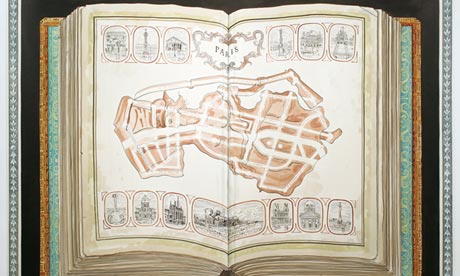

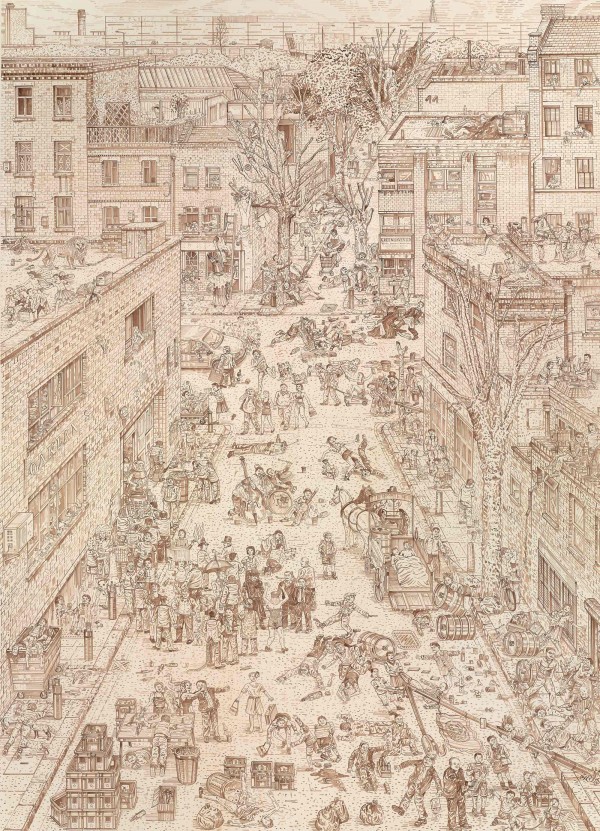

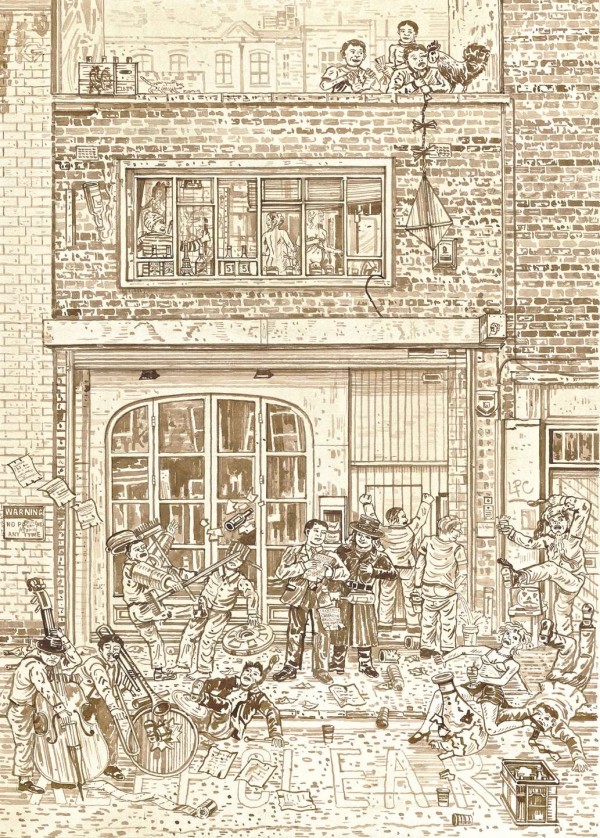
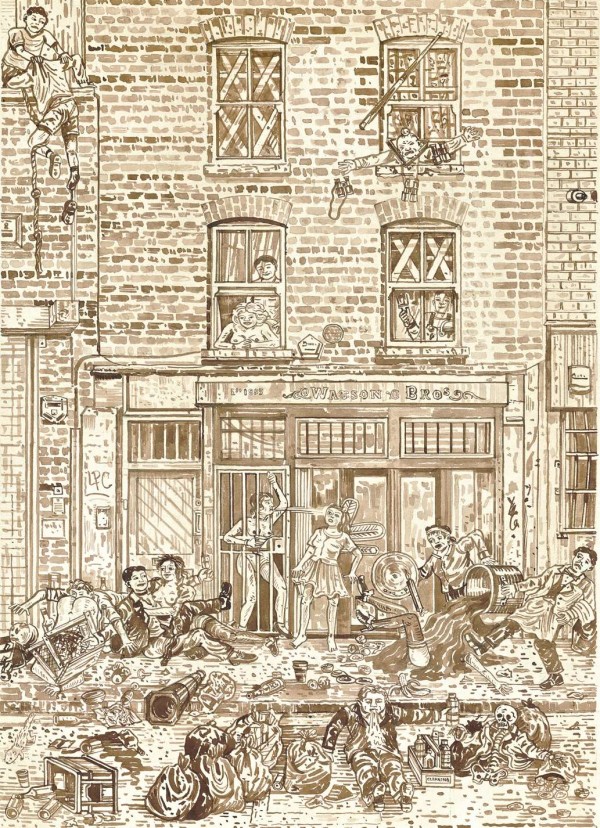
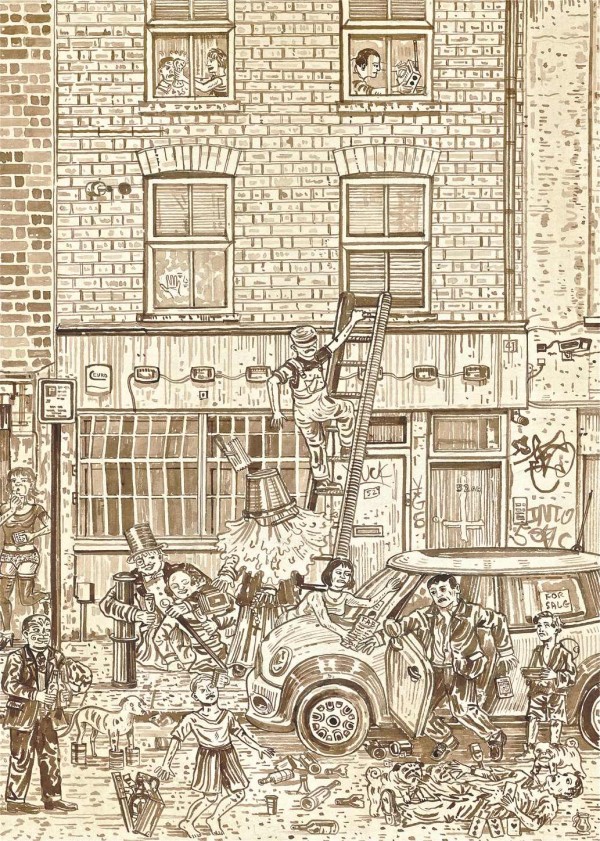
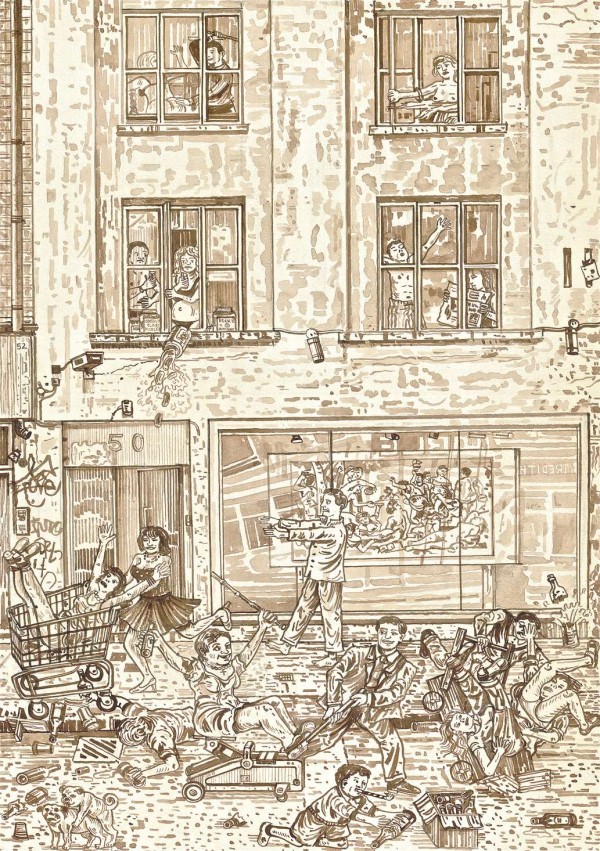
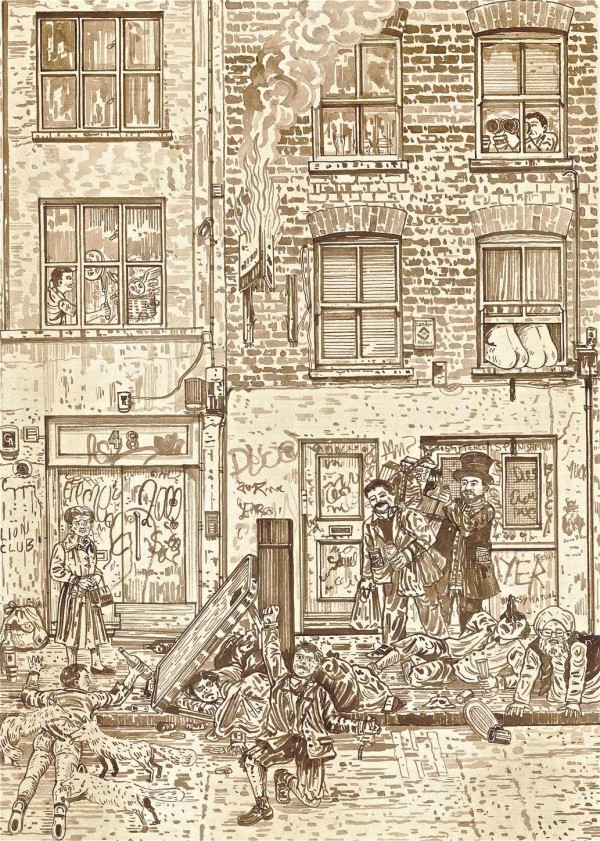
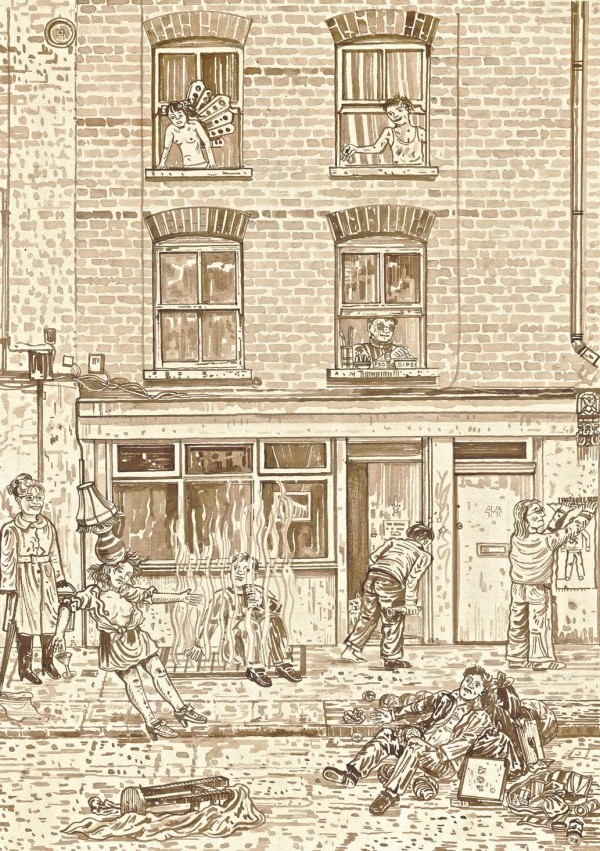
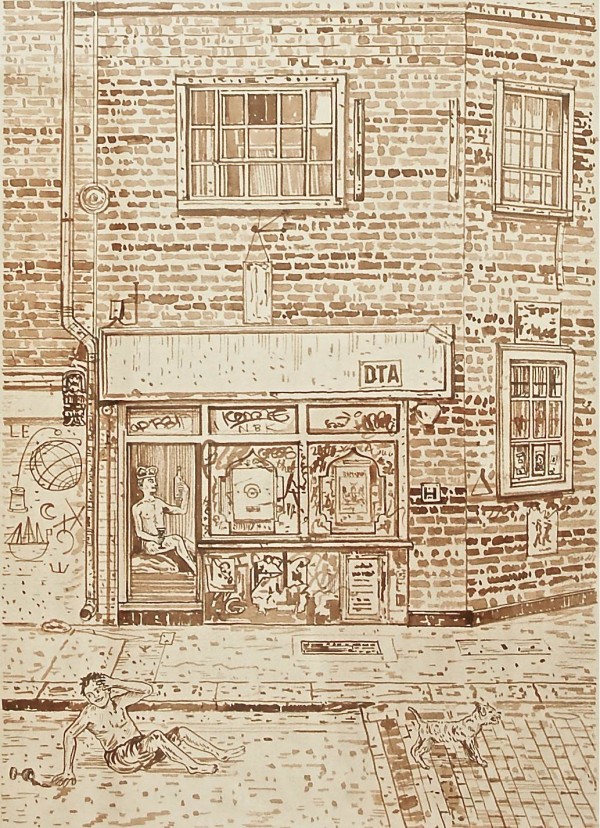
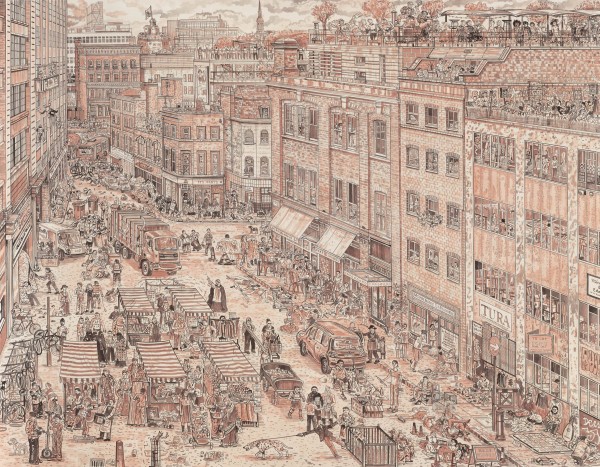
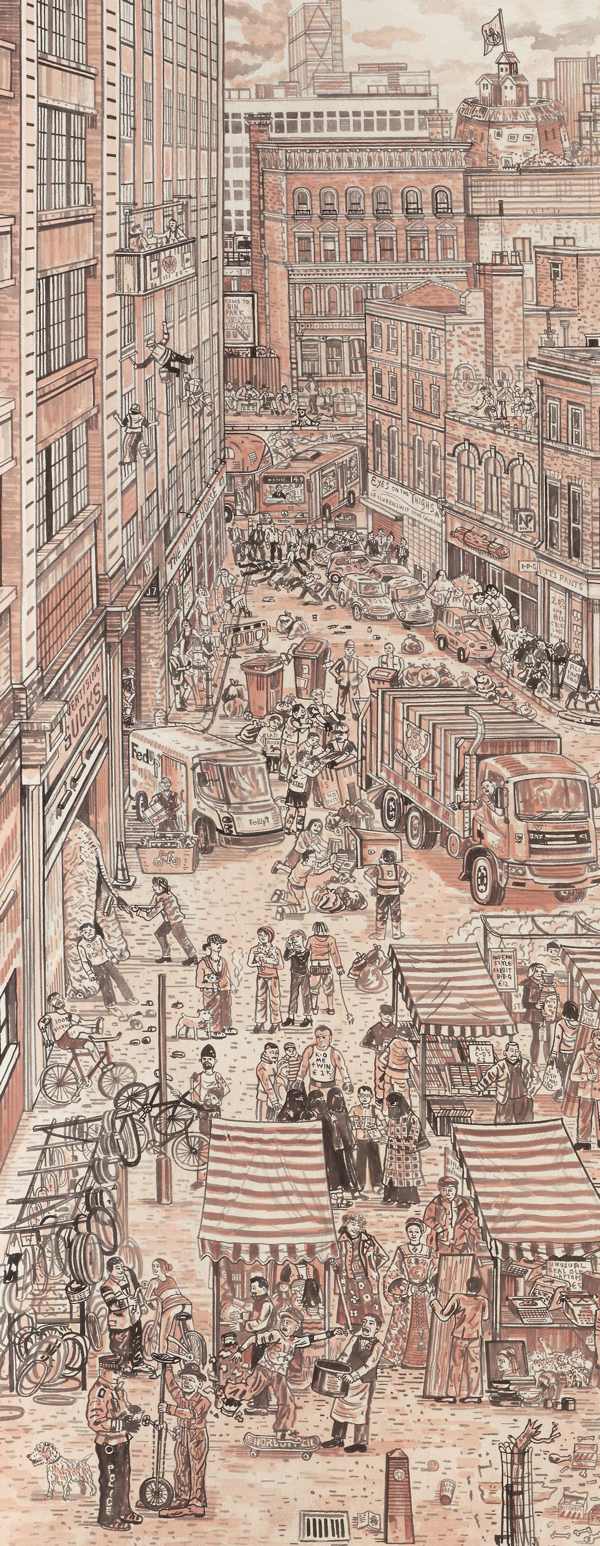
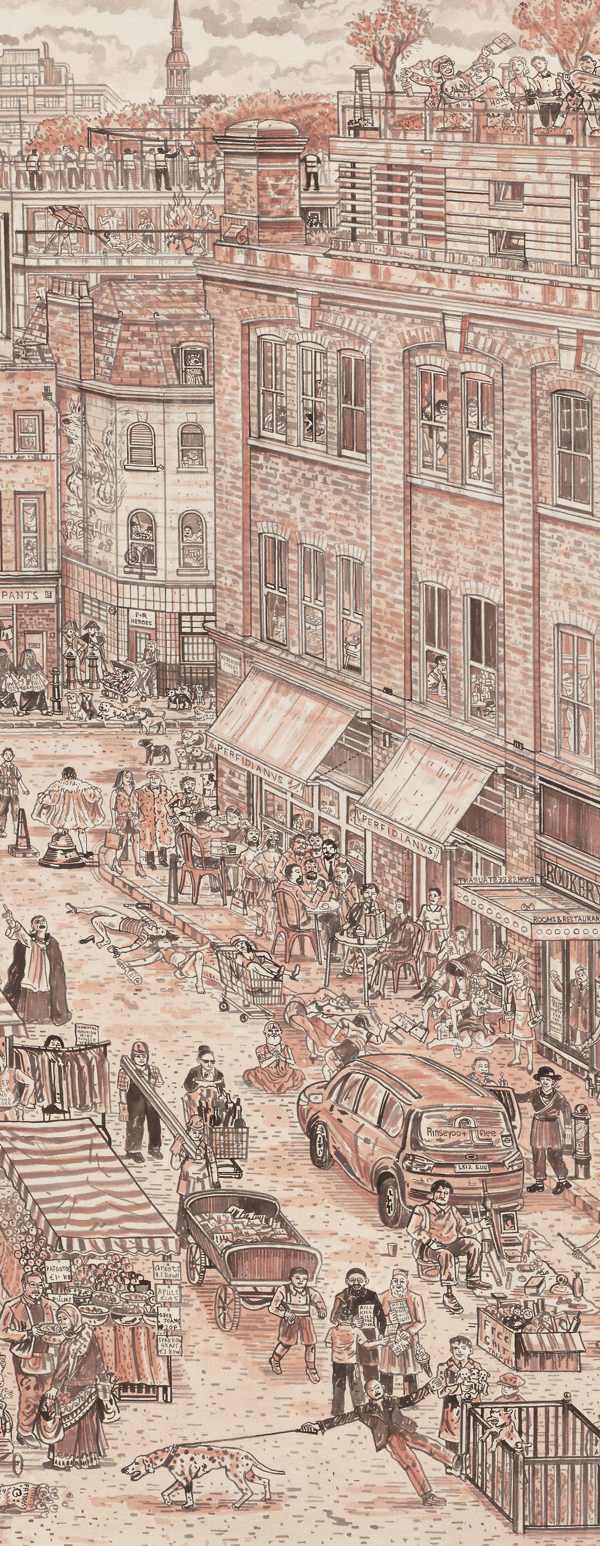
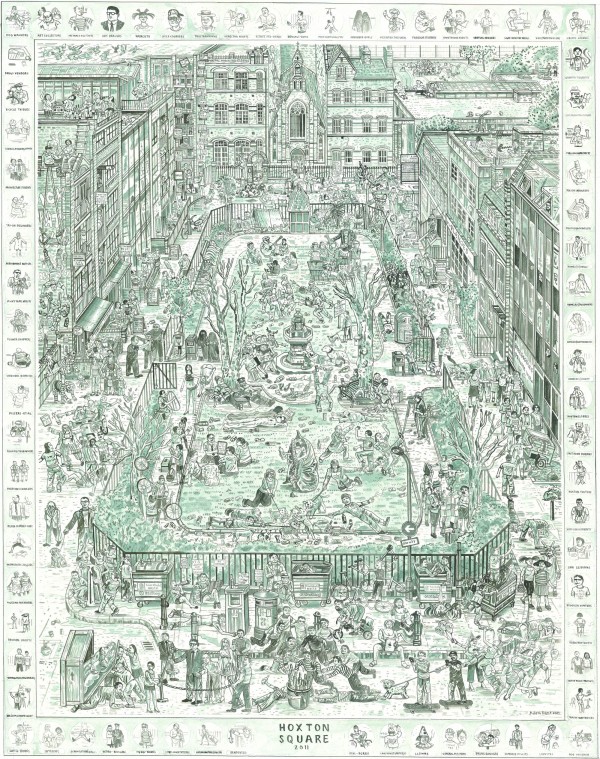

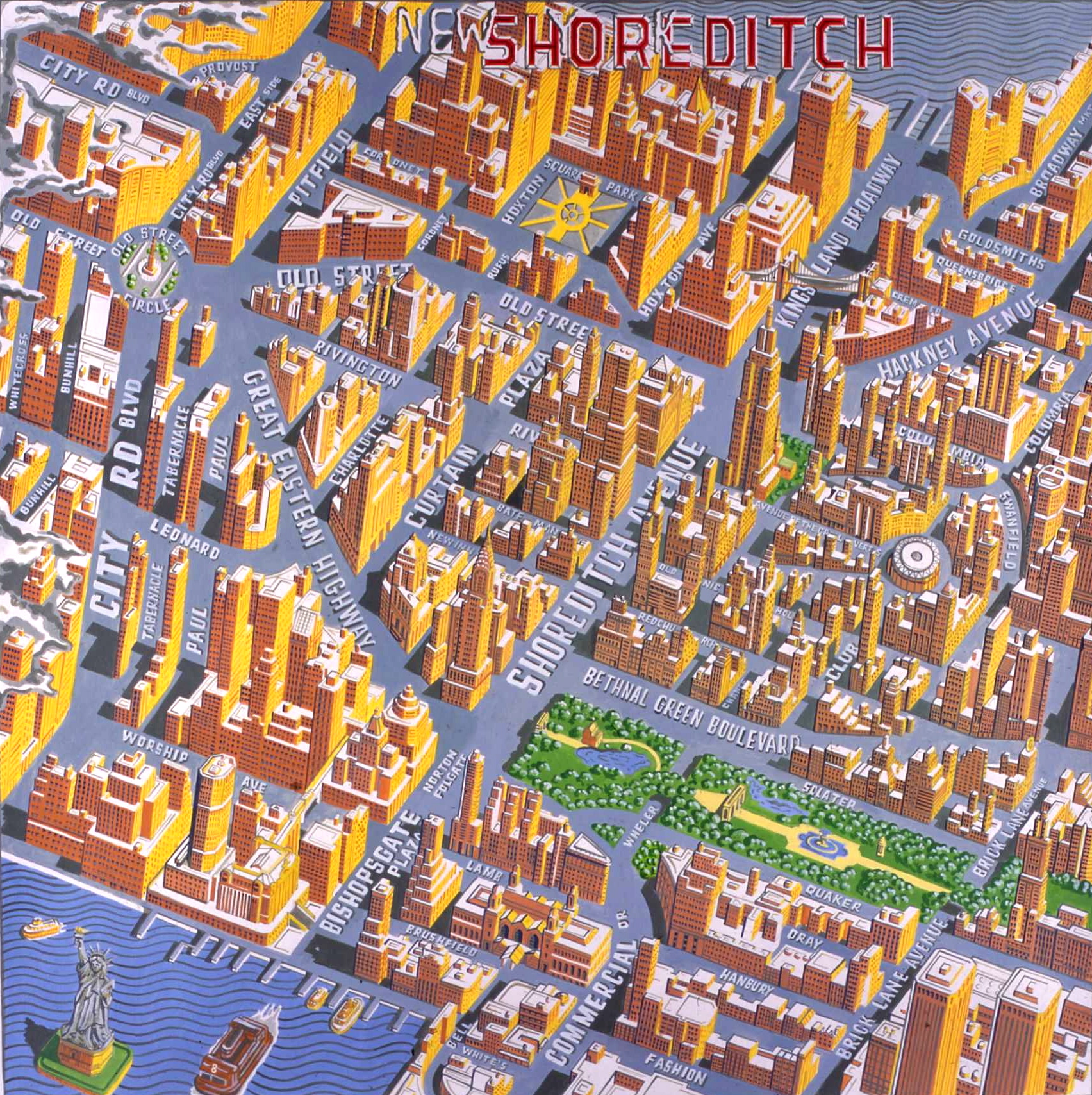
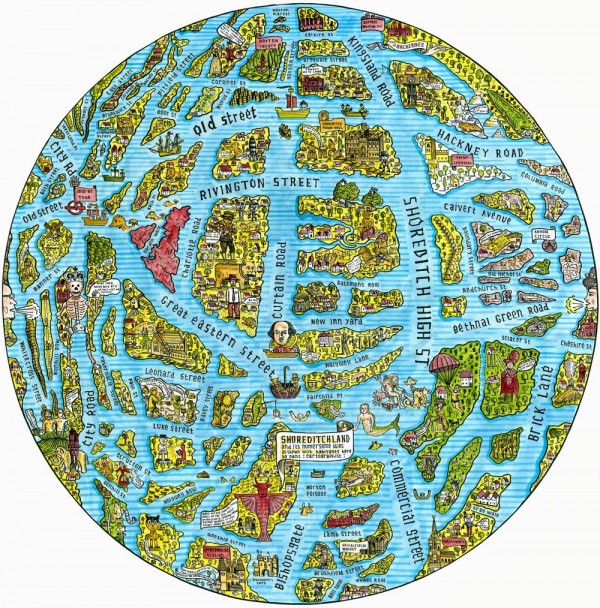
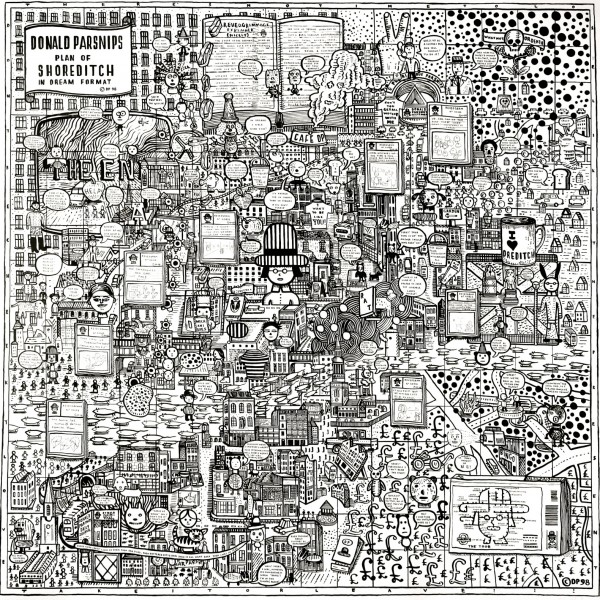
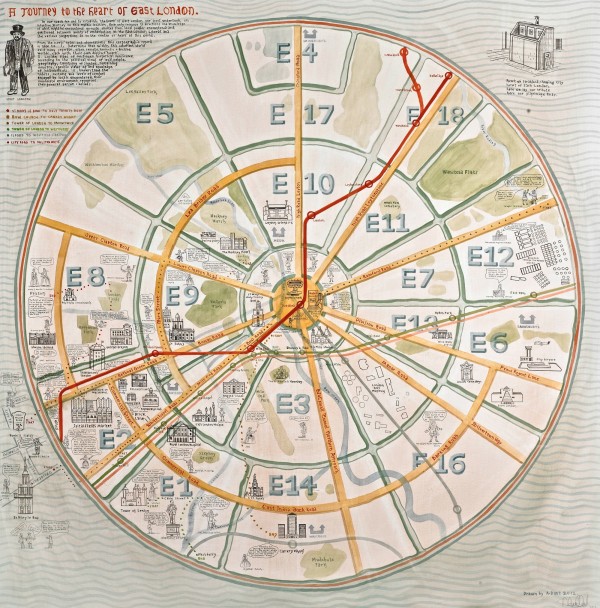
Nema komentara:
Objavi komentar